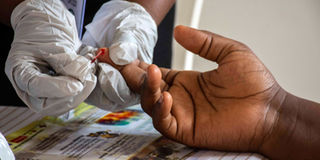Prime
Rethink strategies in HIV/Aids fight

A health worker draws blood from a man to test for HIV in Kampala on September 9. Uganda is set to start using an injectable HIV/Aids drug. PHOTOS | ISAAC KASAMANI
What you need to know:
- There is a need to reinforce comprehensive sex education in our schools, combat stigma and discrimination, and ensure access to youth-friendly healthcare services.
Health officials in Kabarole District have raised the red flag over the increasing rate of HIV/Aids infections among women. Despite the HIV/Aids prevalence rate remaining at 17 percent in Fort Portal City, they say there is an alarming trend of new infections being registered in women than in men.
For instance, between October and December last year, the city registered at least 237 new HIV/Aids cases from 13 health facilities, 137 of which were women. The stakeholders stress that if this pattern is not addressed urgently, it could pose a significant burden on the city’s efforts to eradicate the scourge by 2030.
While Kabarole is being used as a case study, the situation is not any different across the country. The Uganda Aids Commission last year said in its report: “From the age of 15 to 34, the HIV prevalence in women increases rapidly, which shows that during those young ages, those young women are contracting HIV.” Generally, the World Health Organisation says out of 1.4 million people living with the disease in Uganda, 860,000 are women, representing 61.4 percent.
Poverty, gender inequality, intergenerational and transactional sex, ignorance, domestic violence, and socio-cultural norms are attributed to this trend of the virus spread, where women are reported to be at greater risk of vulnerability. Further research indicates that HIV/Aids fight efforts have been focused more on risky sexual behaviours among adults and not much on access to HIV prevention and care services, especially among the youth.
There are also calls to re-strategise, especially in terms of HIV/Aids messaging among the youth. It is believed that young people no longer consider HIV/Aids as a killer disease and that they can tell a person living with the disease by their physical appearance, thereby risking it all in exchange for financial gains and a soft life.
There is a need to reinforce comprehensive sex education in our schools, combat stigma and discrimination, and ensure access to youth-friendly healthcare services. We should also address the socio-economic factors such as unemployment that render young women vulnerable to vices such as sex work. Addressing archaic traditional norms that limit young women’s power to seek knowledge and make informed decisions on their sexual reproductive health should also be at the forefront of our renewed fight against the epidemic. All these and more are better realised with intentional investment from all stakeholders.




